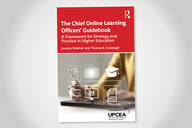You have /5 articles left.
Sign up for a free account or log in.
There are a lot of smart people talking about higher education these days. One of these people is New York University's Scott Galloway. His book The Four: The Hidden DNA of Amazon, Apple, Facebook, and Google was one of my favorite reads of 2017.
Still, I think Galloway is wrong about the big-tech future of higher education.
Sometimes smart people get it wrong.
Galloway’s “rant” (his description, not mine) on higher education, The College Implosion, and his recent interview in New York's "Intelligencer" are good places to start. Here’s what he has to say:
Ultimately, universities are going to partner with companies to help them expand. I think that partnership will look something like MIT and Google partnering. Microsoft and Berkeley. Big-tech companies are about to enter education and health care in a big way, not because they want to but because they have to.
Galloway goes on to say, “People ask if big tech wants to get into education and health care, and I say no, they have to get into education and health care. They have no choice.”
There are two reasons that Galloway is wildly overestimating the future impact of big tech on big ed. The first is that I’m skeptical that technology companies will likely not make large investments in higher education. The reason is that most college students in the U.S. attend public institutions. Of the approximately 20 million students enrolled in degree-granting institutions, about 15 million attend public colleges or universities. Further, enrollment in community colleges represents the largest proportion of all public university enrollment, with almost six million students attending public two-year institutions. The Community College Research Center at Columbia University estimates that 44 percent of all undergraduates are enrolled at community colleges.
What this means is that any forecast about the future of higher education must account in general for the role of public universities, and in particular for the importance of community colleges. It is at our community colleges that the plurality of all postsecondary students receive their educations. Flagship public R-1 institutions such as Berkeley certainly command a disproportionate share of both attention and funding, but they educate a relatively small proportion of all students.
It is difficult to see how big tech companies will enter into strategic partnerships with public universities driven by missions of access and affordability. These schools have little funding to invest in partnerships, as trends in state-level disinvestment have driven a long-running set of financial challenges at these institutions. What exactly the business model is that would entice big tech to invest in or partner with the cash-strapped public institutions the majority of college students attend is a question that Galloway never addresses.
Perhaps Galloway thinks that big tech will avoid public higher education -- at least the nonflagship public universities -- and enter higher education through the for-profit space? This is also highly doubtful. Of the approximately 20 million college students enrolled in degree-granting institutions, less than a million attend for-profit schools. And the trend is only going away from for-profits, whose enrollment peaked at over two million in 2010, with drops of around 100,000 students in each subsequent year.
So if big tech were to enter the higher ed space, it would have to do so mostly with public institutions, almost all of which will be nonprofit. The challenge for big tech is that the missions of companies and schools are fundamentally misaligned. Colleges and universities, both private and public, are not built to maximize revenue, but to optimize around the public good.
This mission may take the form of the open-access missions of community colleges and nonflagship state schools, or it may revolve around the integration of knowledge creation (research) with teaching. In almost every case, the time horizons of nonprofit institutions are measured in decades, not quarters. Even the best-capitalized technology companies cannot afford to take the extremely long view of most colleges.
My second argument with Galloway is that he seems to think big tech will be attracted to the higher education sector because of the high margins and potential profits that colleges and universities can achieve.
To illustrate his point, Galloway gives the example of the class he teaches at the NYU Stern School of Business.
I’ll have 170 kids in my brand-strategy class in the fall. We charge them $7,000 per student. That’s $1.2 million that we get for 12 nights of me in a classroom. $100,000 a night. The gross margins on that offering are somewhere between 92 and 96 points. There is no other product in the world that’s been able to sustain 90-plus points of margin for this long at this high of a price point. Ferrari can’t do it. Hermès can’t do it. Apple can’t do it. Apple’s gross margins are 38 points. Hermès and luxury goods are somewhere between 50 and 60 points. There has never been a luxury item that’s been able to garner the type of gross margins as university education.
If all of higher ed were like Galloway’s NYU class, then yes, higher ed would be an incredible business ripe for the entry of big tech. The reality, for good or ill, is quite different. First, Galloway focuses on the sticker price, rather than the true cost paid by students. The average discount rate for first-time freshmen is today over 50 percent. For all undergraduates, the discount rate is over 46 percent. Since 2007, the discount rates for new freshmen and all undergraduates have climbed from a starting place of 39 and 35 percent respectively. At private, nonprofit colleges and universities, almost 90 percent of students receive some form of financial aid.
Instead of being cash cows, the financial model of most colleges and universities is incredibly brittle. Most tuition-dependent schools are on a knife’s edge of solvency, with an unexpectedly low yield putting the entire economic model at risk. Galloway would likely claim that colleges and universities have created their own problems, by pushing up costs through unnecessary expenses such as hiring student life professionals and the building of fancy residence halls and athletic facilities.
The reality is that colleges and universities are forced to provide these services to attract the few numbers of full-paying students while keeping down the discount rate (and increasing the yield) for everyone else. Spend less on campus services, and fewer students will enroll and matriculate, and more will drop out.
Big tech makes its money through scale. The marginal cost of each additional Google search, iPhone or Microsoft Office license declines with the number of customers. Higher education faces significant limits on its ability to scale. Quality in higher education is largely a function of the mentoring and coaching that faculty are able to provide to students. Educational quality is tightly coupled with the ratio of student to faculty. Reducing institutional costs by hiring contingent rather than tenure-track faculty, or offering ever larger lecture classes, will inevitably result in a less valuable educational experience.
Contrary to popular belief, online education is not less expensive to provide than residential education. The costs, mostly in the need to employ nonfaculty educators such as instructional designers to work with professors on designing their courses, is just different than the costs of residential education. Think less money for buildings, and more money for educators and learner support.
Will big tech have a role to play in the future of higher education? I have been predicting for years that Coursera would make a tempting acquisition target for one of the big four. We may see Google/Apple/Microsoft/Facebook increase their involvement in the higher ed sector, but this role is likely to be restricted mostly to the growing number of noncredit online programs. An interesting development to be sure, but big tech’s influence on the future of higher education will continue to be marginal at best.
In Galloway’s defense, I’m focusing on just two of his higher ed themes. He has a lot to say about the present and future of higher education, ideas that are both informed and provocative.
All of us in higher education benefit from the sort of critique that Galloway offers.
The fact that he gets wrong the impact that big tech will have on higher ed should not dissuade us from engaging with his ideas.




